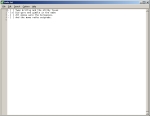A long time ago, I used to keep notes and lists with a normal, everyday text editor, and just draw up a outline format if I needed to show some sort of structure or to-do checkboxes.
Sometime around 2008 or 2009, I found two new applications that quickly took over those roles — one was vimwiki, which I may only need for another day or two, and hnb. hnb was on my system, in spite of its age, for a long five years until I found tudu last summer.
hnb and tudu (and the emacs and vim plugins that do much the same thing) are not the only hierarchical note-takers available. You can add ol to that list, with my endorsement … whatever that’s worth. 🙄
ol stands for “Outliner Lighto,” if the home page is to be believed. And what you see in that image is probably the best snapshot of what it does and how it works.
Arrow keys will navigate through a tree, and leaf nodes expand when you navigate through them. Press “d” to delete a note and all its children, Enter to edit a note, “t” to convert it to a checkbox for to-do lists, “x” to mark a task as done, and so forth. The empty file startup screen will give you help and instructions, if you need it.
Probably one of my favorite things about ol is the cut-and-paste action, or better called the “grab” function. Press “g” and you carry a note with you through the tree, allowing you to arrange and rearrange to your heart’s desire.
Since the display effectively updates as you navigate, it’s a lot easier to organize and visualize than the traditional cut-and-paste model. I like that a lot more than tudu’s way, which borrows yank-and-paste style of vim. And you know how I feel about vim. 👿
ol is also colorful, even going so far as to assign colors to note depths, which is another wise evolution. hnb and tudu haven’t picked up that idea yet, and it’s one that is probably worth adopting.
I see that ol is written in pascal, which strikes me as unusual, but also completely irrelevant to using the program. As an added bonus, if you’re an hnb user and decide to use this moment to emigrate, there’s a utility that will convert hnb’s text format to a style ol can use.
ol doesn’t have some of the more detailed functions of tudu — like displaying a percentage complete for to-do lists, or allowing extended notes, deadlines and schedule dates. ol probably won’t dethrone tudu for me, for those reasons. I find with tudu that I can rely less on wyrd now too.
That alone is no reason to deny ol the gold star it deserves — for a clean interface, plenty of startup help, easy controls and a few innovative ideas for hierarchical list tools. Don’t spend it all in one place: ⭐ Enjoy! 🙂












